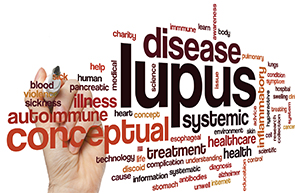
Image Credit: lculig/shutterstock.com
The field of rheumatology took center stage when a handful of speakers discussed trends and research during a disease-oriented session of the 2015 Federation of Clinical Immunity Societies (FOCIS 2015) conference held in San Diego in June.
Neutrophils in SLE
Mariana Kaplan, MD, chief of Systemic Autoimmunity Branch at the National Institute of Arthritis and Musculoskeletal and Skin Diseases (NIAMS), spoke about the role of neutrophils in systemic lupus erythematosus (SLE) and other autoimmune diseases.
In the past couple of years, an effort has been made to define neutrophils as an “important shaper of the immunological landscape,” Dr. Kaplan said. Her recent research has concentrated on neutrophil extracellular traps (NETs), which in lupus may serve to amplify disease by activating inflammation.
Lupus is an autoimmune syndrome that affects mostly young women and is characterized by profound clinical heterogeneity, noted Dr. Kaplan.

Dr. Kaplan
“It is considered one of the big imitators in the clinic, because lupus can really present in so many different ways,” she said. “The disease is typically characterized by episodes of flares and remissions, and it is this smoldering disease and periods of flares we think that significantly contribute to morbidity and mortality in the long term.”
Most patients with lupus require chronic use of immunosuppressant drugs. Although the survival rate has improved compared with the latter half of the past century, the standard mortality rate for lupus is still significantly higher than in the general population, Dr. Kaplan said (also see “SLE: Why Race Still Matters”).
“We know that lupus patients have a striking increase in their risk of developing cardiovascular diseases, such as myocardial infarction and stroke, and it’s quite likely that it is the immune dysregulation characteristic of lupus that is driving this enhanced risk.”
A significant proportion of lupus patients have increased production of type 1 interferons, which mediate the disease and likely play an important role in promoting abnormalities and end complications like cardiovascular disease. Some of the answers to what feeds this interferon production appear to be tied to neutrophils produced in bone marrow. In the past, neutrophils have been somewhat ignored because they die so fast, are hard to manipulate and the short life span makes them difficult to study, Dr. Kaplan said.
“So we have proposed that perhaps how neutrophils die may be particularly important in the context of autoimmunity, because as we all know neutrophils are the most abundant white blood cell.”
Not all neutrophils are created equal, and they also have more than one route to cell death, Dr. Kaplan said. Enter NETs, an interconnected group of extracellular neutrophil fibers that bind themselves to pathogens and release DNA that promotes inflammatory responses in lupus.
Research indicates that NETs are strong inducers of type 1 interferons, which amplify vascular damage and may play a role in the development of vascular‑related lesions seen in lupus, Dr. Kaplan said. Other studies indicate that NETs may be a strong activator to NLRP3 inflammasome machinery in macrophages, she said.
In concluding her talk, Dr. Kaplan proposed that aberrant neutrophils play prominent roles in lupus through the modification and externalization of antigens that amplify the body’s immune response.
Interferon in Lupus

Dr. Elkon
The discussion of lupus continued with Keith Elkon, MD, head of the rheumatology division at University of Washington School of Medicine, Seattle. He began by noting that interferon is thought to be very important in lupus, and in many patients there is a striking signature of interferon in the skin.
Dr. Elkon reviewed ongoing research on skin-related disease flares in lupus that are triggered by sunlight, and he shared results from an unpublished study on mice exposed to ultraviolet (UV) light. The study took a systematic approach to expose normal mice to UVB light every day at around the same time for five consecutive days.
Rather than taking an animal and exposing it to a high dose of UV light and seeing what is stimulated, the researchers wanted to “make it more similar to what goes on for a human walking around in the sunlight,” Dr. Elkon explained. Skin changes, such as rashes and lesions, are an important part of lupus diagnosis criteria.
Researchers observed changes at each time point, conducted biopsies to analyze cell infiltrates and looked at reduced cytokines and activated pathways. Results showing a modest induction of type 1 interferon led them to further test interferon-receptor knock-out mice to see what would happen when interferon stimulation is blocked.
“To our surprise, instead of making this disease better, it actually made it worse,” Dr. Elkon said.
There was increased inflammation and increased redness in skin lesions. There was also an increase in inflammatory cytokines, TNF IL-6 and IL-1.
“So if you take away interferon, you actually get an increase in the inflammatory response,” Dr. Elkon said. “So that of course tells us that type 1 interferon in these animals may actually suppress inflammation.”
Results from this study indicate that in normal mice, repetitive UV light induces a modest amount of interferon that appears to be a protective mechanism for wound healing, Dr. Elkon concluded. The key unanswered question and one that continues to be studied at his lab is how the response might differ in patients with lupus, he said.
Pathogenesis of RA
Michael Holers, MD, a professor of medicine who heads the Rheumatology Division at the University of Colorado, Denver, devoted much of his talk to findings and questions on the pathogenesis of rheumatoid arthritis (RA).
Over the past 15 years, Dr. Holers and his team of researchers have focused on trying to figure out how someone can go from seemingly completely normal to developing the destructive disease of RA. He highlighted “interesting insights into the real origins” of the disease and data that autoimmune diseases begin far earlier than diagnosis.
In one study, researchers accessed a military repository of 50 million serum samples and identified 83 patients with stored blood samples obtained up to 10 years before they were clinically diagnosed with RA.
Symptoms of the disease in this cohort began an average of several months prior to the actual diagnosis. The samples revealed that a majority of this time period was characterized by a tremendous increase in autoreactivity to various peptides and also to cytokines and chemokines, explained Dr. Holers.
It is like a “gathering storm” effect as the disease evolves, he said. The data revealed the possibilities of understanding the disease in the very early period before clinical development of RA.

Dr. Holers
Dr. Holers included an overview of studies involving populations at high risk for developing RA. He noted that when screening at-risk populations, researchers saw the same elevations of cytokines and chemokines that were seen in the retrospective study of military samples.
The presentation wrapped up with Dr. Holers’ hypothesis that the disease of RA is a mucosal-driven process.
“What we see in our studies of at-risk populations is circulating autoimmunity and evidence of mucosal abnormalities,” he said.
A number of RA prevention approaches, such as risk-modifications that include smoking cessation and diet supplementation with Omega 3 fatty acids, are ongoing, Dr. Holers said. He noted that a new prevention study has just received funding to look at high-risk populations of RA antibody-positive, but disease-negative individuals.
Catherine Kolonko is a medical writer based in Oregon.



